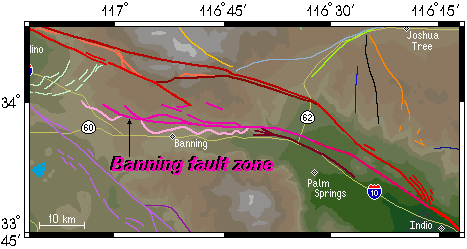Banning Fault
Located northeast of the San Gorgonio Pass, the Banning Fault is a right lateral strike slip fault that runs parallel to its neighboring fault, the Garnet Hill fault, through the Coachella Valley and merges with the San Gorgonio thrust fault. The Banning fault is reportedly active in Millard Canyon and generally along the eastern end of the fault, whereas the western end (west of the Cottonwood Canyon and into the San Gorgonio Pass) has not shown any evidence of recent rupture or activity (Yule and Sieh 2003). Further east, the Banning fault then peters out and merges with the San Andreas fault.
Both the Banning fault and the Garnet Hill strand of the San Andreas have roles to play behind the complex fault behavior of the San Gorgonio Pass. Both faults tend to exhibit more strike slip behavior farther away from the San Gorgonio Fault Zone, but naturally, as they get closer to the heart of the thrust fault, they tend to show more dip slip characteristics. Interestingly, this transition between strike slip and dip slip tendencies lies within the Cottonwood Canyon, an area located right in the middle of the San Gorgonio fault zone (Yule and Sieh 2003). However, because 1) the Banning fault runs alongside to the Garnet Hill fault and 2) both interact with the San Gorgonio thrust fault, the issue of which fault is more active and whether or not there is slip transfer between these faults is raised.
In this study, alternate block models were run, where a block boundary is traced along the San Gorgonio thrust fault and the Banning fault and another where a block boundary is traced along the San Gorgonio thrust fault and the Garnet Hill strand. This page will focus on solely the Banning fault trace and the trials testing the variations among dip, locking depth and strike along this boundary.

